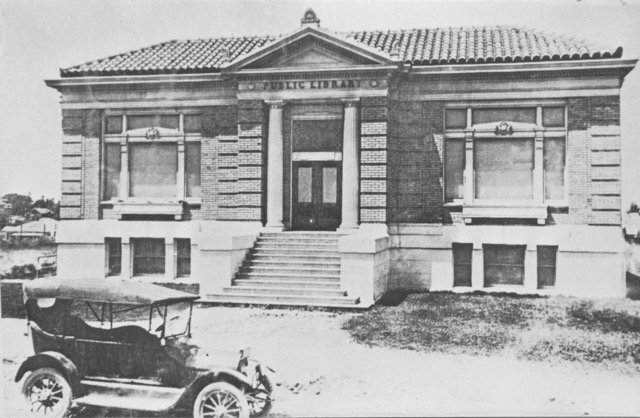
Pacific Fruit Express ice plant, Roseville, CA. 1913.
Pacific Fruit Express Ice Plant
Built in 1909, the Pacific Fruit Express ice making plant made it possible to refrigerate reefer cars filled with perishable fruits and vegetables. Producing 2.5 million tons of ice in 1946, it was the world’s largest ice making plant. It closed in 1973 and was razed the following year.

Ice House Bridge
Originally situated above Southern Pacific’s railyards, this bridge provided safe access for employees working at the Pacific Fruit Express ice making plant. After the ice house was demolished, the bridge was moved to downtown Roseville for use as a public footbridge over Dry Creek in Royer Park in 1986. It was dedicated the following year as the Reuben F. Nelson footbridge. It currently serves as part of the Royer Park bike/walking trail.

Sierra Scene
A scene typical of an area near Donner Lake in the Sierra Nevada Mountains shows rugged mountainous terrain, including tunnels and snow sheds, along California’s portion of the nation’s first transcontinental railroad. In 1863 the Central Pacific Railroad built east from Sacramento and the Union Pacific Railroad built west from Omaha, Nebraska. The rails met at Promontory Summit in Utah on May 10, 1869.

Sierra Vista Bridge
Originally built of wood, then rebuilt in 1929 with concrete, this bridge is located directly across Lincoln Street from the Carnegie Museum. It has been known by many names over the years, including Crooked Bridge and Rainbow Bridge.

Carnegie Library
With a $10,000 donation from the Andrew Carnegie Foundation, $2,000 from the Women’s Improvement Club of Roseville and on land donated by local businessman A. B. McRae, Roseville built its first permanent library in 1912. It became a branch library in 1979 after the Taylor Street library was built. Closed in 1982, it opened as the Roseville Historical Society’s Carnegie Museum in 1988.

Lincoln St. Circa 1908.
Lincoln Street
Lincoln Street was the main Roseville business area in the 1920’s and an important link to Vernon Street. It remained so until completion of the Washington Boulevard underpass in 1950.

Southern Pacific Clubhouse
The Clubhouse was built in 1909 for railroad crews passing through and rail workers who did not have a home in Roseville. It was torn down in the 1950’s after completion of the Seawell Underpass, which carries Washington Boulevard traffic beneath the railyard. The site of the Clubhouse is now occupied by the intermodal train and bus depot.

Roundhouse No. 1
Constructed in 1907 as part of Southern Pacific’s Big Move, Roundhouse No. 1 had 32 stalls for servicing yard and switcher engines, as well as locomotives used for snow removal assistance in the Sierra Nevada Mountains. It was torn down in 1955.

Roundhouse No. 2
A second and much larger Roundhouse was built by Southern Pacific in 1914. It also had 32 stalls, but they were built to accommodate large cab forward steam locomotives. These were some of the largest steam locomotives ever built and designed to carry heavy freight loads over the Sierra Nevada Mountains. This Roundhouse was demolished in 1962, after the steam era, and replaced by today’s diesel-electric locomotive repair facility.

The Big Move of 1906-1908
As Southern Pacific continued to grow, the railroad needed to expand its Rocklin operations. Since suitable land was available in Roseville, the railroad moved its operations there. As a result, Southern Pacific and Roseville saw unprecedented growth. Today the Roseville yard, encompassing approximately 950 acres, is one of the largest railroad yards west of the Mississippi River.

Roseville Railyard Explosions
In April 1973, explosions occurred in the Antelope section of the Roseville railyards. Twenty-one boxcars loaded with munitions in route to Vietnam began to burn and explode. Continuing for hours, the explosions threw shrapnel and unexploded ordinance over the surrounding area. This caused massive damage to Antelope, destroyed tracks, and overturned locomotives and railcars. Many homes and businesses were damaged or destroyed, but no lives were lost.

Roseville Union High School
Roseville’s first high school classes were held in 1912 at the Golden Eagle Saloon and Lodging House on Vernon Street. As Roseville’s population grew following the Big Move, the city dedicated Roseville Union High School in 1916. The school was torn down in 1970. Its replacement stands today on Tahoe Avenue.

Denio’s Farmers Market
Opened in 1947 by founder Jim Denio, selling produce from the back of his pickup truck, Denio’s Farmers Market operates to this day. It’s a Roseville institution and has grown into northern California’s oldest and largest outdoor shopping attraction. Its 70 acres provides space for hundreds of vendors.

Nisenan Maidu Native American Lands
The most significant structures erected by the Nisenan Maidu Native Americans were ceremonial roundhouses, which were combination spiritual and social centers in larger town sites. The Nisenan Maidu were a hunter-gatherer people who, beginning about 2,000 years ago, roamed the watershed areas of the American River in present-day Yuba, Nevada, Placer, Sacramento and El Dorado Counties.